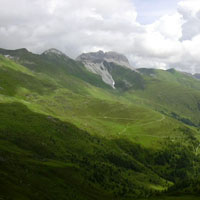Climate change impacts on the Alpine, Continental and Mediterranean grassland systems of Italy: A review

Accepted: 8 June 2021
HTML: 87
All claims expressed in this article are solely those of the authors and do not necessarily represent those of their affiliated organizations, or those of the publisher, the editors and the reviewers. Any product that may be evaluated in this article or claim that may be made by its manufacturer is not guaranteed or endorsed by the publisher.
The ongoing climate change, which is threatening grassland agroecosystems throughout Europe, is also evident in the Italian grasslands. These systems, often located in marginal areas, are species-rich ecosystems characterized by variable, and often unreliable, grass and forage production and strongly dependent on interactions between climate, soil and agricultural management practices (e.g. land abandonment, lack of investments on innovation, stocking rates reduction, etc.), making them very sensitive and vulnerable to climate change. This review draws from the scientific literature the impacts of current and expected climatic changes on grassland and forage crop systems framed in three different bio-climatic zones of Italy, namely the Alpine, Continental and Mediterranean, and focussing on: i) grassland biodiversity and vegetation; and ii) forage production and quality. The main aims of this review are to: i) revise the existing literature in the domain, highlighting different or common trends among different Italian biogeographical regions; ii) provide information on the main climatic impacts analysed and drivers involved in the studied evolutions; and iii) point out the knowledge gaps currently pending in order to hypothesize the future scenarios of research in this sector. Even if this review has pointed out differences in approaches, adopted methodologies and purposes of conducted researches, some common trends can be highlighted, though located in three different environments. Expected warming and modification on rainfall pattern will produce deep changes in vegetation of grassland types, with reduction or the disappearance of cold tolerant species and a spread of xeric/thermophilus ones and shrubby vegetation and with a general upward shift of vegetation types in mountain areas. Moreover, a general reduction of aboveground biomass is expected, as summer droughts is considered a main driver able to force grassland productivity. Finally, warming and rainfall reduction are considered the main factors able to reduce forage quality and palatability of grasslands, as a consequence of reduction of nitrogen content in the available biomass and of the higher spread of less unpalatable species and shrubs. The hypothesis is that the information gained from this review can provide insights on the current level of knowledge on the expected impacts of climate change on Italian grassland systems, and support the development of policy strategies for adaptation at national level.
Highlights
- This review highlights grassland systems responses to climate change in the Alpine, Apennine and Mediterranean areas of Italy.
- Future climate will determine deep changes in grassland composition, extension and productivity.
- Droughts is considered the main factor affecting forage quality and palatability.
- Further research is needed to understand climate change impacts on grassland vegetation in the Mediterranean.
How to Cite

This work is licensed under a Creative Commons Attribution-NonCommercial 4.0 International License.
PAGEPress has chosen to apply the Creative Commons Attribution NonCommercial 4.0 International License (CC BY-NC 4.0) to all manuscripts to be published.

 https://doi.org/10.4081/ija.2021.1843
https://doi.org/10.4081/ija.2021.1843



